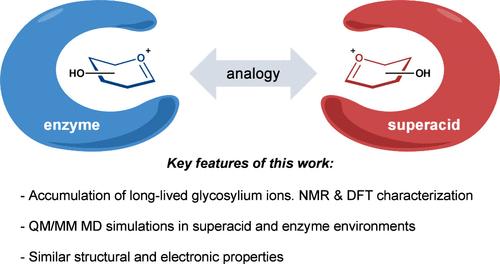当前位置:
X-MOL 学术
›
J. Am. Chem. Soc.
›
论文详情
Our official English website, www.x-mol.net, welcomes your
feedback! (Note: you will need to create a separate account there.)
Glycosylium Ions in Superacid Mimic the Transition State of Enzyme Reactions
Journal of the American Chemical Society ( IF 14.4 ) Pub Date : 2024-11-13 , DOI: 10.1021/jacs.4c11677 Mathilde Armand, Alba Nin-Hill, Ana Ardá, Emanuela Berrino, Jérôme Désiré, Agnès Martin-Mingot, Bastien Michelet, Jesús Jiménez-Barbero, Yves Blériot, Carme Rovira, Sébastien Thibaudeau
Journal of the American Chemical Society ( IF 14.4 ) Pub Date : 2024-11-13 , DOI: 10.1021/jacs.4c11677 Mathilde Armand, Alba Nin-Hill, Ana Ardá, Emanuela Berrino, Jérôme Désiré, Agnès Martin-Mingot, Bastien Michelet, Jesús Jiménez-Barbero, Yves Blériot, Carme Rovira, Sébastien Thibaudeau

|
The hydrolysis of glycosides is a biochemical transformation that occurs in all living organisms, catalyzed by a broad group of enzymes, including glycoside hydrolases. These enzymes cleave the glycosidic bond via a transition state with substantial oxocarbenium ion character, resulting in short-lived oxocarbenium ion-like species. While such transient species have been inferred through theoretical studies and kinetic isotope effect measurements, their direct spectroscopic characterization remains challenging. In this study, we exploit a superacid environment to generate, accumulate, and fully characterize nonprotected 2-deoxy glycosyl cations in the d-glucopyranose, d-galactopyranose, and l-arabinofuranose series using low-temperature NMR spectroscopy, supported by DFT calculations. Additionally, QM/MM MD simulations reveal that the properties of these glycosyl cations in superacid closely resemble those within the active sites of glycosidase enzymes, particularly in terms of conformation and anomeric charge distribution. These findings highlight a parallel between the stabilizing effect of counterions in superacid media and the network of multidentate noncovalent interactions within glycosidase active sites, which stabilize transition states with pronounced oxocarbenium ion character.
中文翻译:

超酸中的糖基离子模拟酶反应的过渡态
糖苷的水解是发生在所有生物体中的生化转化,由包括糖苷水解酶在内的广泛酶催化。这些酶通过具有大量氧碳烯离子特性的过渡态裂解糖苷键,导致短寿命的氧碳烯离子样物质。虽然已经通过理论研究和动力学同位素效应测量推断出这种瞬态物质,但它们的直接光谱表征仍然具有挑战性。在这项研究中,我们利用超酸环境,使用低温 NMR 波谱法在 DFT 计算的支持下,使用低温吡喃葡萄糖、d-吡喃半乳糖和 l-阿拉伯呋喃糖系列中生成、积累和完全表征非受保护的 2-脱氧糖基阳离子。此外,QM/MM MD 模拟显示,这些糖基阳离子在超酸中的特性与糖苷酶活性位点内的特性非常相似,特别是在构象和异头电荷分布方面。这些发现突出了超酸介质中反离子的稳定作用与糖苷酶活性位点内的多齿非共价相互作用网络之间的相似性,后者以明显的氧代碳烯离子特性稳定过渡态。
更新日期:2024-11-14
中文翻译:

超酸中的糖基离子模拟酶反应的过渡态
糖苷的水解是发生在所有生物体中的生化转化,由包括糖苷水解酶在内的广泛酶催化。这些酶通过具有大量氧碳烯离子特性的过渡态裂解糖苷键,导致短寿命的氧碳烯离子样物质。虽然已经通过理论研究和动力学同位素效应测量推断出这种瞬态物质,但它们的直接光谱表征仍然具有挑战性。在这项研究中,我们利用超酸环境,使用低温 NMR 波谱法在 DFT 计算的支持下,使用低温吡喃葡萄糖、d-吡喃半乳糖和 l-阿拉伯呋喃糖系列中生成、积累和完全表征非受保护的 2-脱氧糖基阳离子。此外,QM/MM MD 模拟显示,这些糖基阳离子在超酸中的特性与糖苷酶活性位点内的特性非常相似,特别是在构象和异头电荷分布方面。这些发现突出了超酸介质中反离子的稳定作用与糖苷酶活性位点内的多齿非共价相互作用网络之间的相似性,后者以明显的氧代碳烯离子特性稳定过渡态。


















































 京公网安备 11010802027423号
京公网安备 11010802027423号